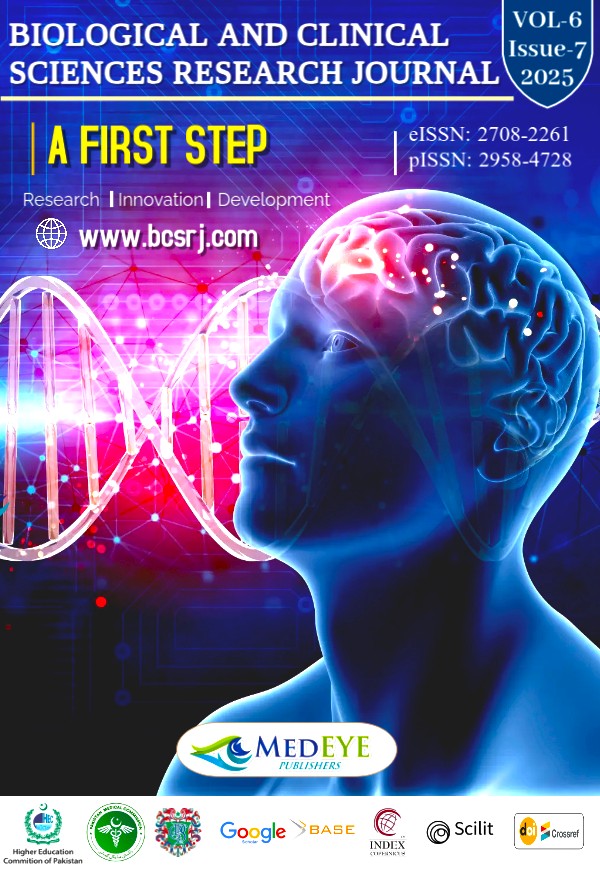Correlation Between Materials-induced Irritation and Oral Mucosal Lesions
DOI:
https://doi.org/10.54112/bcsrj.v6i7.1894Keywords:
Oral mucosa, irritation, lesions, tobacco, prosthetic materials, carcinomaAbstract
Material-induced irritation of the oral mucosa can result in a spectrum of lesions, ranging from benign reactive changes to potentially malignant disorders and oral squamous cell carcinoma (OSCC). Establishing correlations between specific irritants and lesion types is critical for prevention, early diagnosis, and effective management. Objective: To evaluate the relationship between material-induced irritation and the development of oral mucosal lesions, with emphasis on risk factors, clinical presentation, and histopathological patterns. Methods: This cross-sectional study was conducted in the Department of Dental Materials, Ayub Medical College, Abbottabad, from April to September 2024. A total of 160 patients aged ≥18 years with clinically and histopathologically confirmed oral mucosal lesions related to irritant exposure (mechanical, chemical, or metallic) were included. Detailed histories, clinical examinations, and photographic documentation were undertaken, followed by incisional or excisional biopsies for diagnosis. Lesions were classified as reactive, potentially malignant disorders (PMDs), or OSCC. Data were analyzed using chi-square and Pearson correlation tests, with p<0.05 considered significant. Results: Of the participants (mean age 43.5 ± 12.2 years; 57.5% male), 71.3% had lesions linked to chronic mechanical irritants, while 28.7% were associated with chemical irritants. Buccal mucosa (42.5%) and lateral tongue (28.1%) were the most common sites. Histopathology revealed reactive lesions in 47.5%, PMDs in 32.5%, and OSCC in 20.0% of cases. Mechanical irritants (ill-fitting dentures, orthodontic appliances) were predominantly associated with reactive lesions, whereas chemical irritants (smokeless tobacco, nicotine) correlated more with PMDs and OSCC. Metallic restorations were significantly linked with lichenoid lesions. A strong positive correlation was found between duration of irritant exposure and lesion severity (r=0.62, p=0.002). Conclusion: Chronic material-induced irritation is a significant risk factor for oral mucosal pathology, with prolonged exposure markedly increasing the likelihood of malignant transformation. Early detection and removal of irritants, patient education, and preventive measures are vital to reduce lesion progression and improve oral health outcomes.
Downloads
References
Wang D, Woo SB. Histopathologic spectrum of intraoral irritant and contact hypersensitivity reactions: a series of 12 cases. Head Neck Pathol. 2021 Dec;15(4):1172–84. https://doi.org/10.1007/s12105-021-01330-8
Gupta AA, Kheur S, Varadarajan S, Parveen S, Dewan H, Alhazmi YA, et al. Chronic mechanical irritation and oral squamous cell carcinoma: A systematic review and meta-analysis. Bosn J Basic Med Sci. 2021 Dec 1;21(6):647–58. https://doi.org/10.17305/bjbms.2021.5577
Aizawa S, Yoshida H, Umeshita K, Watanabe S, Takahashi Y, Sakane S, et al. Development of an oral mucosal irritation test using a three-dimensional human buccal oral mucosal model. Toxicol In Vitro. 2023 Mar;87:105519. https://doi.org/10.1016/j.tiv.2022.105519
Ueno T, Yatsuoka W, Ishiki H, Miyano K, Uezono Y. Effects of an oral mucosa protective formulation on chemotherapy- and/or radiotherapy-induced oral mucositis: a prospective study. BMC Cancer. 2022 Jan 21;22(1):90. https://doi.org/10.1186/s12885-021-09107-6
Vasanthi V, Divya B, Ramadoss R, Deena P, Annasamy RK, Rajkumar K. Quantification of inflammatory, angiogenic, and fibrous components of reactive oral lesions with an insight into the pathogenesis. J Oral Maxillofac Pathol. 2022 Dec;26(4):600. https://doi.org/10.4103/jomfp.jomfp_138_21
Kumari P, Debta P, Dixit A. Oral potentially malignant disorders: etiology, pathogenesis, and transformation into oral cancer. Front Pharmacol. 2022 Apr 20;13:825266. https://doi.org/10.3389/fphar.2022.825266
Mahmoud MS, Taha MS, Mansour OI, Barakat E, Allah SA, Omran A, et al. Oral mucosal lesions during SARS-CoV-2 infection: a case series and literature review. Egypt J Otolaryngol. 2022 Dec;38(1):18. https://doi.org/10.1186/s43163-022-00203-3
Watanabe T, Kawahara D, Inoue R, Kato T, Ishihara N, Kamiya H, et al. Squamous cell carcinoma around a subperiosteal implant in the maxilla and the association of chronic mechanical irritation and peri-implantitis: a case report. Int J Implant Dent. 2022 Mar 2;8(1):10. https://doi.org/10.1186/s40729-022-00409-3
Noor AE, Ramanarayana B. Relationship of smokeless tobacco use from the perspective of oral cancer: A global burden. Oral Oncol Rep. 2024 Jun;10:100516. https://doi.org/10.1016/j.oor.2024.100516
Wysocka-Słowik A, Gil L, Ślebioda Z, Kręgielczak A, Dorocka-Bobkowska B. Oral mucositis in patients with acute myeloid leukemia treated with allogeneic hematopoietic stem cell transplantation about the conditioning used prior to transplantation. Ann Hematol. 2021 Aug;100(8):2079–86. https://doi.org/10.1007/s00277-021-04568-y
Alizadehgharib S, Lehrkinder A, Alshabeeb A, Östberg AK, Lingström P. The effect of a non-tobacco-based nicotine pouch on mucosal lesions caused by Swedish smokeless tobacco (snus). Eur J Oral Sci. 2022 Aug;130(4):e12885. https://doi.org/10.1111/eos.12885
Ciesielska A, Kusiak A, Ossowska A, Grzybowska ME. Changes in the oral cavity in menopausal women—a narrative review. Int J Environ Res Public Health. 2021 Dec 27;19(1):253. https://doi.org/10.3390/ijerph19010253
Du F, Qian W, Zhang X, Zhang L, Shang J. Prevalence of oral mucosal lesions in patients with systemic lupus erythematosus: a systematic review and meta-analysis. BMC Oral Health. 2023 Dec 21;23(1):1030. https://doi.org/10.1186/s12903-023-03783-5
Tsushima F, Sakurai J, Shimizu R, Kayamori K, Harada H. Oral lichenoid contact lesions related to dental metal allergy may resolve after allergen removal. J Dent Sci. 2022 Jul 1;17(3):1300–6. https://doi.org/10.1016/j.jds.2021.11.008
Zebardast A, Yahyapour Y, Majidi MS, Chehrazi M, Sadeghi F. Detection of Epstein–Barr virus encoded small RNA genes in oral squamous cell carcinoma and non-cancerous oral cavity samples. BMC Oral Health. 2021 Oct 7;21(1):502. https://doi.org/10.1186/s12903-021-01867-8
da Mota Santana LA, de Andrade Vieira W, Gonçalo RI, Dos Santos MA, Takeshita WM, Miguita L. Oral mucosa lesions in confirmed and non-vaccinated cases for COVID-19: a systematic review. J Stomatol Oral Maxillofac Surg. 2022 Oct 1;123(5):e241–50. https://doi.org/10.1016/j.jormas.2022.05.005
Wu YH, Chiang CP. Association of medications with burning mouth syndrome in Taiwanese aged patients. J Dent Sci. 2023 Apr 1;18(2):833–9. https://doi.org/10.1016/j.jds.2023.01.009
Daume L, Kreis C, Bohner L, Jung S, Kleinheinz J. Clinical characteristics of oral lichen planus and its causal context with dental restorative materials and oral health-related quality of life. BMC Oral Health. 2021 May 15;21(1):262. https://doi.org/10.1186/s12903-021-01622-z.
Kot WY, Li JW, Chan AK, Zheng LW. A reflection on COVID-19 and oral mucosal lesions: a systematic review. Front Oral Health. 2023 Dec 18;4:1322458. https://doi.org/10.3389/froh.2023.1322458
Kawashita Y, Kitamura M, Soutome S, Ukai T, Umeda M, Saito T. Association of neutrophil-to-lymphocyte ratio with severe radiation-induced mucositis in pharyngeal or laryngeal cancer patients: a retrospective study. BMC Cancer. 2021 Sep 28;21(1):1064. https://doi.org/10.1186/s12885-021-08793-6
Limdiwala PG, Shah JS, Parikh SJ, Pillai JP. Oral manifestations in patients with gastro-esophageal reflux disease: a hospital-based case-control study. J Indian Acad Oral Med Radiol. 2023 Jan 1;35(1):56–60. https://doi.org/10.4103/jiaomr.jiaomr_116_21
Downloads
Published
How to Cite
Issue
Section
License
Copyright (c) 2025 Rabia Anwar, Ayesha Bibi

This work is licensed under a Creative Commons Attribution-NonCommercial 4.0 International License.








